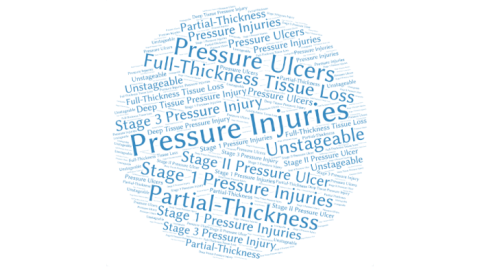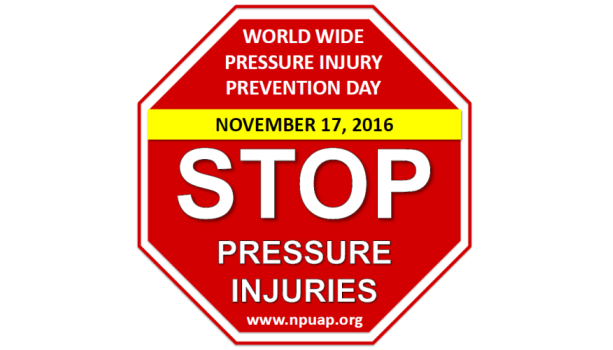Pressure Ulcer or Pressure Injury: Is There a Difference?
July 7, 2016
The April National Pressure Ulcer Advisory Panel (NPUAP) consensus conference resulted in a terminology change from pressure ulcer to pressure injury, and also validated new terminology which more accurately describes pressure injury in intact and ulcerated skin. The previous staging system described both Stage 1 and Deep Tissue Injury as injured intact skin and the other stages described open ulcers. There has been confusion because the definitions for each of the stages referred to the injuries as "pressure ulcers". The term "suspected" was removed form the Deep Tissue Injury diagnostic label and Arabic numbers are now used instead of roman numerals.
Dr. Mikel Gray guided the Staging Committee Task Force and over 400 meeting participants to consensus on the updated definitions through an interactive discussion and voting process. Participants at the meeting also validated the new terminology using photographs. Schematic artwork for each of the stages of pressure injury are available free of charge from the NPUAP's website.
The updated staging system includes the following definitions:
Pressure Injury
A pressure injury is localized damage to the skin and/or underlying soft tissue usually over a bony prominence or related to a medical or other device. The injury can present as intact skin or an open ulcer and may be painful. The injury occurs as a result of intense and/or prolonged pressure or pressure in combination with shear. The tolerance of soft tissue for pressure and shear may also be affected by microclimate, nutrition, perfusion, co-morbidities and condition of the soft tissue.
Stage 1 Pressure Injury: Non-blanchable erythema of intact skin
Intact skin with a localized area of non-blanchable erythema, which may appear differently in darkly pigmented skin. Presence of blanchable erythema or changes in sensation, temperature, or firmness may precede visual changes. Color changes do not include purple or maroon discoloration; these may indicate deep tissue pressure injury.
Stage 2 Pressure Injury: Partial-thickness skin loss with exposed dermis
Partial-thickness loss of skin with exposed dermis. The wound bed is viable, pink or red, moist, and may also present as an intact or ruptured serum-filled blister. Adipose (fat) is not visible and deeper tissues are not visible. Granulation tissue, slough and eschar are not present. These injuries commonly result from adverse microclimate and shear in the skin over the pelvis and shear in the heel. This stage should not be used to describe moisture associated skin damage (MASD) including incontinence associated dermatitis (IAD), intertriginous dermatitis (ITD), medical adhesive related skin injury (MARSI), or traumatic wounds (skin tears, burns, abrasions).
Stage 3 Pressure Injury: Full-thickness skin loss
Full-thickness loss of skin, in which adipose (fat) is visible in the ulcer and granulation tissue and epibole (rolled wound edges) are often present. Slough and/or eschar may be visible. The depth of tissue damage varies by anatomical location; areas of significant adiposity can develop deep wounds. Undermining and tunneling may occur. Fascia, muscle, tendon, ligament, cartilage and/or bone are not exposed. If slough or eschar obscures the extent of tissue loss this is an Unstageable Pressure Injury.
Stage 4 Pressure Injury: Full-thickness skin and tissue loss
Full-thickness skin and tissue loss with exposed or directly palpable fascia, muscle, tendon, ligament, cartilage or bone in the ulcer. Slough and/or eschar may be visible. Epibole (rolled edges), undermining and/or tunneling often occur. Depth varies by anatomical location. If slough or eschar obscures the extent of tissue loss this is an Unstageable Pressure Injury.
Unstageable Pressure Injury: Obscured full-thickness skin and tissue loss
Full-thickness skin and tissue loss in which the extent of tissue damage within the ulcer cannot be confirmed because it is obscured by slough or eschar. If slough or eschar is removed, a Stage 3 or Stage 4 pressure injury will be revealed. Stable eschar (i.e. dry, adherent, intact without erythema or fluctuance) on an ischemic limb or the heel(s) should not be removed.
Deep Tissue Pressure Injury: Persistent non-blanchable deep red, maroon or purple discoloration
Intact or non-intact skin with localized area of persistent non-blanchable deep red, maroon, purple discoloration or epidermal separation revealing a dark wound bed or blood filled blister. Pain and temperature change often precede skin color changes. Discoloration may appear differently in darkly pigmented skin. This injury results from intense and/or prolonged pressure and shear forces at the bone-muscle interface. The wound may evolve rapidly to reveal the actual extent of tissue injury, or may resolve without tissue loss. If necrotic tissue, subcutaneous tissue, granulation tissue, fascia, muscle or other underlying structures are visible, this indicates a full thickness pressure injury (Unstageable, Stage 3 or Stage 4). Do not use DTPI to describe vascular, traumatic, neuropathic, or dermatologic conditions.
The new staging definitions clarify the age-old issue of clinicians staging other types of wounds such as vascular, traumatic, neuropathic and dermatologic conditions. There are also definitions for medical device related pressure injury and mucosal membrane pressure injury, which can be accessed at www.npuap.org. It is noted that mucous membrane pressure injuries should not be staged due to the anatomical difference between mucous membrane tissue and skin. An illustration of mucous membrane is provided to clarify those differences on the website. Medical device related pressure injuries on areas other than mucous membranes should be staged according to the revised classification system.
Clinicians are encouraged to use the new terminology and staging system in their practice. The NPUAP is continuing to work with the Centers for Medicare & Medicaid and the ICD-10 Coding Group on the implementation process for the new terminology and staging system. Wound, Ostomy and Continence Nurses Society™ and the Academy of Nutrition and Dietetics have both sent the NPUAP letters of support for the new terminology and staging system. The Pressure Injury Prevention Points education tool has also been updated and can be download from the web site. Click here to review the FAQs on the NPUAP website to answer additional questions on the staging system changes.
About The Author
Mary Ellen Posthauer RDN, CD, LD, FAND is an award winning dietitian, consultant for MEP Healthcare Dietary Services, published author, and member of the Purdue University Hall of Fame, Department of Foods and Nutrition, having held positions on numerous boards and panels including the National Pressure Ulcer Advisory Panel and the American Dietetic Association's Unintentional Weight Loss work group.
The views and opinions expressed in this blog are solely those of the author, and do not represent the views of WoundSource, HMP Global, its affiliates, or subsidiary companies.












Follow WoundSource
Tweets by WoundSource